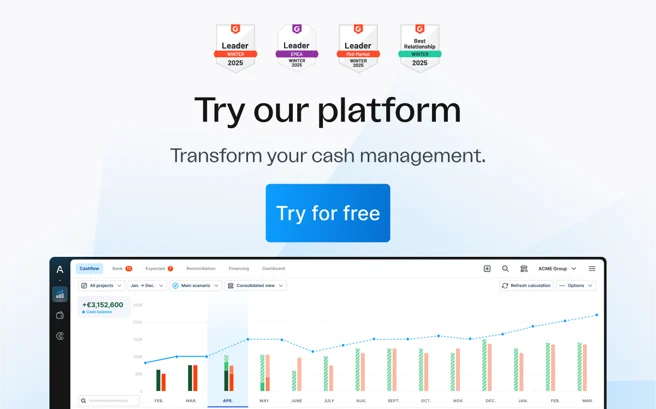Free cash flow to equity: Concept, components, and calculation

The key to evaluating a company’s financial health and its ability to reward its equity shareholders lies in calculating Free Cash Flow to Equity (FCFE). It provides insights into how much cash is available to distribute to the company's equity holders after covering operational and capital expenses. This also explains why analysts use this metric to value a company’s equity.
In this article, we will explain everything there is to know about FCFE, including its components and calculation methods.
What is meant by Free Cash Flow to Equity? Definition
Free Cash Flowto Equity (FCFE) represents the amount of cash available for distribution to the common stockholders of a company. This residual amount is distributed to equity shareholders in the form of dividends and share buybacks. However, the money paid out to shareholders at the end of the year does not have to equal FCFE.
FCFE is arrived at by accounting for all company obligations, such as reinvestment, capital expenditure (CapEx), debt payments, and other operating expenses, from the total cash generated during a given financial year. Many analysts use this cash flow metric to value a company, especially when applying dividend discount models (DDMs) is not feasible.
FCFE Components
As FCFE is only concerned with the cash available to equity shareholders, starting with the net income is the usual practice. This is because all interest expenses and the subsequent tax savings have already been deducted from the net income. Accordingly, FCFE has the following components:
-
Net income: It is the accounting measure of the total profit or loss attributable to the company’s shareholders after paying all expenses. It is located on the income statement. Alternatively, it can be found in the cash flow from operations (CFO) section when arriving at using the indirect method.
-
Depreciation and amortisation (D&A): These are non-cash expenses that reduce the book value of assets over time and must be added back because they have no impact on the company’s cash flow. Like net income, they can be found on the income statement or in the CFO column.
-
Changes in working capital: It is the difference between the firm’s current assets and current liabilities, including receivables, inventory, and payables. FCFE includes these changes because an increase in working capital reduces cash flows, while a decrease in working capital indicates an increase in cash available to equityinvestors. It is found in the CFO section of the cash flow statement (CFS).
-
Capital expenditures (CapEx): Representing the cost of acquisition of long-term assets such as property, plant, and equipment, capex is deducted from the net income as it reduces the cash available to shareholders. It is found in the cash flow from investing (CFI) section of the cash flow statement.
-
Net debt: As debt holders have a prior claim on the cash flow of the company, the difference between the debt issued and repaid during the given year is accounted for in FCFE’s calculation. It includes both short and long-term debt and is found on the cash flow statement in the cash flows from financing (CFI) section.
What is net borrowing in FCFE?
Equityshareholders must consider the impact of changes in debt levels as stated on their balance sheet on their cash flows. While debt repayment will surely drain the business’ cash flow, it can also be financed fully or partially by issuing new debt, which will raise cash inflows. So, FCFE includes the net effect of the changes in debt and uses the following formula:
Net borrowing = Debt issued – Debt paydown
However, it is only concerned with scheduled debt payments and ignores the impact of discretionary debt, like cash sweeps.
Free Cash Flow to Equity (FCFE) calculation
While there is no single standardised method to calculate FCFE, it can be arrived at using several approaches. One method is to combine its five components, which are net income, CapEx, changes in working capital, depreciation, and net borrowing. Another approach is to adjust cash flow from operations (CFO) for CapEx and net debt.
FCFE formulas
- FCFE = Net Income + D&A - Change in Net Working Capital - CapEx + Net Borrowing
- FCFE = CFO - CapEx + Net Borrowing
How to calculate free cash flow to equity from EBIT?
Analysts can also estimate FCFE using EBIT if the company's net income is substantially affected by non-core activities.
As,
Net income = EBIT – Interest – Taxes
Substituting this formula in the original net income approach will change it to:
FCFE = EBIT – Interest – Taxes + D&A - Change in Net Working Capital - CapEx + Net Borrowing
This formula can further be adjusted by replacing EBIT with EBITDA and removing the D&A term completely.
How to evaluate Free Cash Flow to Equity?
Evaluating FCFE is necessary as it helps determine whether the firm has generated sufficient cash during the year to pay dividends and repurchase stock. The key step is to calculate the difference between FCFE and the total of the dividend and buyback price (if any).
If there is a shortfall, it signals the company has been paying equity shareholders using debt, new security issues, or retained earnings, which does not bode well for the organization.
However, surpluses can be indicative of the company’s plans to invest in short-term securities for additional income. In case the firm pays out FCFE entirely in dividends, the two values will equate and only work for companies with stable leverage ratios.
Free Cash Flow to Equity example
Let's understand the concept of free cash flow to equity with a simplified example. Assume the following scenario for a hypothetical company, XTR Ltd.:
- Net income: £800,000
- Depreciation and amortisation: £300,000
- Change in NWC: -£75,000
- Capital expenditures: £500,000
- Net borrowing: £200,000
Using the FCFE formula:
- FCFE = £800,000 + £300,000 - (-£75,000) - (£500,000) + £200,000
- FCFE = £875,000
In this scenario, Company XTR’s FCFE is £875,000, which is representative of the cash available for distribution to its equity shareholders.
FCFE vs. other cash flow metrics
In addition to FCFE, business professionals and analysts also compute other cash flow metrics. We explain a few as follows:
What is Free Cash Flow to the firm (FCFF)?
Free Cash Flow to the Firm (FCFF) represents the cash generated by a company that's available to all stakeholders, including equity and debt holders. In other words, it is pre-debt cash flow that has only factored in reinvestment and taxes but not interest and debt payments.
What is the Difference Between FCFF and FCFE?
FCFF and FCFE mainly differ in their consideration of debt and the tax shield. FCFF is a measure of cash flows available to equity shareholders had the company been debt-free, which also explains why it is called unlevered cash flow. In contrast, FCFE is computed after deducting interest and principal payments. Both terms are closely related:
FCFE = FCFF – Interest (1 – Tax rate) + Net borrowing
Why Use FCFE Instead of FCFF?
FCFE is favored when equity holders need to assess the actual cash amount available after taking care of debt-related obligations. It helps ascertain potential dividend payouts and share buyback opportunities.
Free cash flow to equity vs. levered free cash flow
FCFE is also called levered cash flow as it accounts for the company’s capital structure.
How to incorporate FCFE in financial analysis with Agicap
Agicap’s cash flow management software empowers you to automatically pull in and consolidate your cash flow data from all sources without any errors. Using the cash management tool, you can quickly categorize your cash flows, calculate FCFE, and track key trends.
Agicap’s cash flow forecasting tool can also help you estimate future cash flows, visualize the impact of different assumptions on FCFE, and make more informed decisions based on real-time data.






